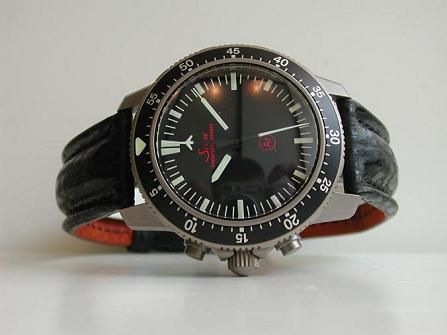Sinn EZM review
Some time ago, Bas van Dorp and I both decided we needed a Lemania 5100 watch. I bought a Sinn 142 St.S at Horloge Platform Nederland in The Hague and Bas ordered a Sinn EZM1. His one was on order, and since the run on the last watches with Lemania 5100 was enormous, he had to wait a bit longer. Last week his watch arrived and here you can read his review on his EZM1.

About two years ago, I read that Lemania would end the production of the
cal. 5100. The horror! The guys who came up with this idea will be the
first against the wall when the revolution comes, that's for sure. Sinn,
among others, would still be producing watches with this movement, using
the remaining stock. I was still happy wearing my Omega Speedmaster
Professional (which has a Lemania 1873), and there was still some time
to decide. However, recently, Sinn has also stopped the production of
5100 based watches, so I quickly decided to order one of the last EZM
1's. I received it 5 days ago...
I like functional designs. The reason I got a Speedmaster Pro was
because it has the best designed chronograph dial ever. Extremely good
to read, beautiful and timeless design. The Sinn EZM 1 shares many of
these features, but in a very different way. But most of all: both
watches make a statement on watch design.
The Sinn has no subdials but it still has a two register chronograph.
That's one of the odd features of the Lemania 5100, it has a central
seconds and a central minutes register. Additional to these four central
hands, the Lemania 5100 allows for three subdials (24 hour hand, normal
seconds hand and chrono hour totalizer), but Sinn didn't use them in the
EZM 1. Who needs these functions anyway? Sinn considers extreme
legibility more important, so let's throw these registers away, even
though we payed for them. A very bold statement.
Both Sinn and Omega considered legibility the most important goal but
they defined their design constraints different. I found the Sinn's
overall legibility better in the dark and I found it is particularly
easier to read the chronograph in the dark. The Omega, however, allows
more accurate and easier reading of the seconds counter in normal
conditions, because of it's "perfect" outer scale where every second has
an identical, very thin marker (now that's a statement). The Sinn
doesn't have this, the markers on the hours are thicker it doesn't even
have a marker on 1 and 59 seconds because of the huge 12 hour marker.
You can still use the chrono, but not to the degree of perfection in the
Speedmaster. I'd say for scientific purposes the Omega is better, but
for the rough work "in the field", the Sinn is better. For timing pasta,
both watches will do just fine. But wait! The Sinn has a rotating bezel
which gives you a countown timer for the pasta so you can use still the
chrono to time the desert in the oven. The date window is a nice bonus,
and Sinn did a perfect job not to make the date window interfere with
the legibility of the rest of the watch. Also a bold statement.
The Sinn looks much more modern, not as timeless as the Speedmaster. But
I do consider the Sinn EZM 1 a classic. Time will tell if I'm right.
Where the Speedmaster Pro looks like a technical instrument, the EZM has
the appearance of a hefty diver's watch, a bit like the IWC Aquatimer,
Omega Seamaster 300 and Rolex Submariner. However, Sinn took the "form
follows function" adagium to a new level. The date indicator is in red
and even the brand and model names are in red. Oh by the way, the model
name, "Einsatzzeitmesser" might be the main reason for me to get this
watch (I like long German words that just say it all).
I have to mention the crown & pushers on the left side (great, all
automatic watches should have this), copper sulphate capsule (great idea
if you ask me), the German lettering on the back, the superbly designed
hands, the clear manual, the not-so-pretty-but-comfortable bracelet, and
the beautiful straps.
I consider the 142, the 157 and the EZM 1 the best designed watches in
the Sinn catalogue so I sincerely hope that Sinn can come up with
replacements for all these great 5100 based watches that are out of
production now. The 656 and 756 lines surely look promising. In the
meanwhile, when people ask: "how much does your watch cost?", I reply:
"that doesn't matter, it's not in production anymore."
